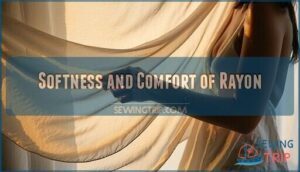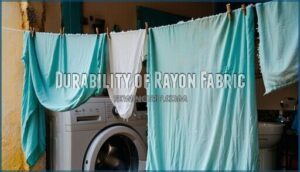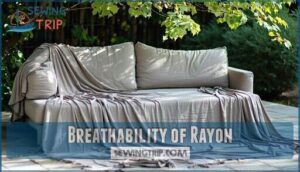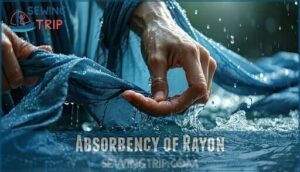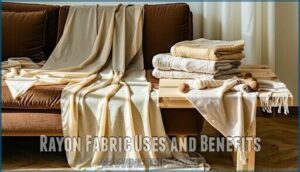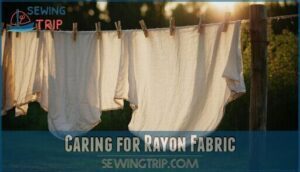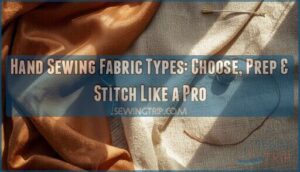This site is supported by our readers. We may earn a commission, at no cost to you, if you purchase through links.
 When you touch rayon fabric, you’ll immediately notice its silky smoothness that feels luxurious yet breathable.
When you touch rayon fabric, you’ll immediately notice its silky smoothness that feels luxurious yet breathable.
It’s softer than cotton but not as slippery as silk, with a cool, fluid texture that drapes beautifully against your skin.
Rayon has this unique ability to feel lightweight and airy while still maintaining structure.
You won’t get that synthetic, plastic-like feel either—it’s genuinely comfortable and becomes even softer with washing.
The fabric moves with you naturally, making it perfect for everything from flowy dresses to cozy loungewear.
Understanding rayon’s specific properties can help you make better fabric choices for your wardrobe needs, considering its ability to feel luxurious yet breathable and its tendency to become even softer with time, showcasing its unique ability.
Table Of Contents
Key Takeaways
- You’ll feel rayon’s silky smoothness – It’s softer than cotton but not as slippery as silk, with a cool, fluid texture that drapes beautifully against your skin.
- It’s lightweight yet structured – You won’t get that synthetic, plastic-like feel; instead, rayon maintains its shape while feeling airy and breathable.
- The fabric becomes softer over time – With each wash, rayon gets even more comfortable, making it a fabric that improves with age.
- It moves naturally with your body – Whether you’re wearing flowy dresses or cozy loungewear, rayon’s drape flows with you rather than restricting movement.
What is Rayon Fabric
You’ve probably touched rayon fabric without even realizing it, since this versatile material shows up in everything from your favorite flowy blouse to those super-soft bed sheets.
Rayon is a semi-synthetic fabric made from natural cellulose fibers, typically sourced from wood pulp, that’s been chemically processed to create a textile that feels remarkably similar to silk or cotton.
Rayon Fabric Composition
Rayon’s composition stems from regenerated cellulose, making up roughly 98% of traditional viscose fibers through textile chemistry processes.
Understanding rayon material properties helps explain why this fabric feels distinctly soft and breathable.
- Cellulose foundation: Wood pulp or cotton linters provide the natural base material
- Chemical processing: Sodium hydroxide and carbon disulfide dissolve cellulose into workable solutions
- Fiber analysis: Long cellulose chains create rayon’s cotton-like yarn structure
- Fabric density: High cellulose content delivers rayon’s characteristic texture and feel
History of Rayon Fabric
Innovation sparked textile revolution when chemists discovered how to transform wood pulp into silk-like fibers during the 1880s.
You’ll find rayon’s development fascinating as it bridged natural and synthetic materials through Industrial Revolution ingenuity.
| Era | Development | Impact |
|---|---|---|
| 1880s | First rayon patents | Textile innovation begins |
| 1920s | Commercial production | Mass market availability |
| 1940s | Improved processes | Enhanced rayon characteristics |
This Fabric Evolution transformed how you experience rayon texture today, establishing the foundation for modern rayon material properties and various types of rayon we recognize.
Manufacturing Process of Rayon
Understanding how rayon gets made helps you appreciate why it feels so luxurious against your skin.
The manufacturing journey transforms raw materials into the soft, silky fabric you love through careful chemical treatment and fiber production.
Here’s how manufacturers create rayon’s signature texture:
- Pulping Process – Wood chips or bamboo dissolve in caustic soda, creating a thick, honey-like substance
- Chemical Treatment – The pulp gets processed with carbon disulfide, forming viscose that’s ready for spinning
- Fiber Production – Machines push the viscose through tiny holes, creating continuous filaments that become rayon threads
These texturizing methods and weaving techniques directly influence rayon fabric characteristics, determining whether you’ll get the smooth drape of viscose rayon or the crisp feel of modal types.
The production process involves understanding rayon vs viscose differences to create the desired fabric properties.
What Does Rayon Feel Like
When you run your fingers across rayon fabric, you’ll discover a texture that feels remarkably similar to silk. The rayon texture offers exceptional fabric softness that makes it comfortable against your skin, whether you’re wearing a blouse or sleeping on rayon sheets.
You’ll notice how the material smoothness creates an almost luxurious sensation that’s hard to resist touching. The rayon drape flows beautifully, giving garments an elegant appearance that moves naturally with your body.
Unlike some synthetic materials that feel stiff or artificial, rayon fabric feel mimics natural fibers while providing superior cloth breathability. Is rayon soft? Absolutely – it’s one of the softest manufactured fabrics available today.
You’ll appreciate how rayon clothing comfort comes from its smooth surface and lightweight nature. The rayon fabric characteristics include a silky hand-feel that doesn’t cling uncomfortably to your skin. This material strikes the perfect balance between durability and gentleness, making rayon fabric texture appealing for everything from casual wear to formal garments that require both comfort and style.
The breathability of rayon is influenced by its fabric weave style, which affects how well it allows airflow and moisture transfer.
Rayon Fabric Characteristics
You’ll notice rayon’s unique texture combines the best of both worlds—it feels as smooth as silk but remains as soft as cotton against your skin.
This fabric’s characteristics make it a favorite for clothing because it drapes beautifully while staying comfortable throughout the day.
Softness and Comfort of Rayon
Soft rayon fabric feels like a gentle embrace against your skin, offering exceptional comfort that rivals natural silk.
This versatile material provides:
- Smooth, silky texture that glides effortlessly
- Breathable comfort for all-day wear
- Gentle touch that won’t irritate sensitive skin
- Luxurious feel at an affordable price
You’ll appreciate how rayon clothing comfort makes every garment feel premium while maintaining incredible fabric softness.
Durability of Rayon Fabric
When wet, rayon’s fabric strength plummets dramatically, losing up to 80% of its durability compared to dry conditions.
This moisture sensitivity directly impacts rayon longevity and wear resistance, making proper rayon fabric care essential for maintaining fiber durability through repeated use.
Understanding rayon fabric properties is vital for handling and maintaining the material effectively.
| Durability Factor | Dry Rayon | Wet Rayon |
|---|---|---|
| Tensile Strength | 2.0-2.6 g/den | 1.0-1.5 g/den |
| Strength Loss | Baseline | 50-80% reduction |
| Tear Testing Results | Moderate resistance | High vulnerability |
| Care Requirements | Standard handling | Gentle treatment needed |
Breathability of Rayon
When you’re choosing rayon for warm weather, its breathable textiles structure offers moderate air permeability that keeps you comfortable.
The fabric’s semi-open weave promotes thermal regulation through enhanced airflow, though fabric density affects performance.
Rayon fabric breathability surpasses most synthetics but falls short of cotton’s moisture wicking capabilities, making it ideal for casual wear.
For more information on rayon and cotton, consider the rayon vs cotton differences regarding durability and care.
Absorbency of Rayon
Rayon’s exceptional moisture absorption sets it apart from many synthetic fabrics, making it feel comfortable against your skin.
The fiber absorbency allows rayon to soak up sweat and humidity effectively, though water retention means it takes longer to dry than polyester.
This liquid wicking property enhances rayon fabric feel during warm weather, while the slower drying speed requires patience during laundry days.
Rayon Fabric Uses and Benefits
You’ll find rayon’s versatility makes it perfect for everything from flowy summer dresses to cozy home decor items.
This adaptable fabric works well in clothing, bedding, towels, and even athletic wear because it combines cotton’s comfort with silk’s elegant drape.
Clothing and Apparel Made From Rayon
Your wardrobe transforms with rayon’s versatility across countless clothing options.
Major fashion brands consistently choose rayon blends for their exceptional drape and breathability, creating garments that feel luxurious without the premium price tag.
- Summer Dresses showcase rayon’s cooling properties and vibrant color retention
- Rayon Suits offer professional polish with silk-like sheen and comfortable wear
- Athletic wear benefits from fabric blends that enhance moisture-wicking performance
- Evening gowns highlight rayon textures that mimic expensive silk fabrics
- Casual shirts demonstrate fashion trends embracing rayon’s lightweight, breathable qualities
When selecting fabrics, considering the natural fiber benefits is ideal to evaluate for best comfort and sustainability.
Home Furnishings and Decor Made From Rayon
You’ll discover rayon upholstery transforms your living space with its luxurious draping qualities and smooth texture.
This versatile textile adapts beautifully to home accents like curtains, throw pillows, and decorative panels.
Rayon fabric feel mimics silk’s elegance while offering superior fabric draping for contemporary decor trends.
Its material properties create stunning textile patterns that enhance furniture and window treatments with sophisticated appeal.
The choice of rayon fabric often depends on rayon upholstery options available for specific projects, which can elevate your space with luxurious draping qualities.
Rayon Fabric for Bedding and Towels
Many bedrooms benefit from rayon’s natural temperature regulation and luxurious fabric texture.
You’ll find rayon fabric breathability creates comfortable sleeping environments while maintaining rayon fabric softness throughout the night.
Here’s why rayon excels in bedding materials:
- Pillowcases and sheets: Modal fabric feel provides silk-like smoothness without the premium price
- Comforters and duvets: Rayon blends offer lightweight warmth with excellent moisture-wicking properties
- Towels and washcloths: Towel softness improves with proper fabric care, becoming more absorbent over time
- Bamboo rayon bedding: Lyocell fabric feel combines eco-friendly production with antimicrobial benefits
- Decorative pillows: Rayon fabric feel adds elegant texture while remaining budget-friendly
When shopping for rayon products, consider exploring rayon bedding options to find the best fit for your needs.
Rayon Fabric for Outdoor and Sports Apparel
Choosing rayon fabric for outdoor activities requires understanding its moisture management limitations compared to synthetic sports textiles.
While rayon fabric breathability helps with airflow, it lacks the quick-drying properties essential for athletic wear.
The fabric’s weight and modal fabric feel provide comfort, but rayon fabric durability suffers when wet, making it less suitable for high-intensity outdoor performance activities.
Caring for Rayon Fabric
You’ll want to handle rayon carefully since it’s more delicate than cotton or synthetic fabrics.
Proper care keeps your rayon garments soft and prevents shrinking, stretching, or losing that silky feel you love.
Washing and Drying Instructions for Rayon
Proper rayon fabric care starts with understanding this delicate material’s unique needs.
Cold water protects rayon’s structure while gentle handling prevents damage that weakens fibers and causes shrinkage.
Follow these essential rayon care steps:
- Hand wash using lukewarm water and mild detergent for vital fabric texture preservation
- Machine wash on delicate cycles with mesh bags to minimize wash cycles damage
- Air dry flat on towels, avoiding direct sunlight to maintain rayon fabric durability
Skip the dryer’s heat and avoid wringing wet garments.
These drying tips guarantee your rayon maintains its signature softness without compromising fabric types integrity or rayon fabric weight.
Understanding rayon fabric care is vital for extending the life of your garments.
Ironing and Steaming Rayon Fabric
Once your rayon fabric’s clean and dry, you’ll want to smooth out wrinkles carefully.
Use medium heat when ironing, as rayon fabric texture can be delicate. Steam works wonderfully for fabric rejuvenation without direct contact.
Always iron on the wrong side to preserve that silky softness and breathability.
These gentle ironing techniques and steaming tips guarantee effective wrinkle removal while maintaining rayon’s luxurious feel.
Storage and Maintenance of Rayon Fabric
Store your rayon pieces by hanging them on padded hangers or folding with tissue paper to prevent creasing.
Keep rayon shelves in cool, dry areas away from direct sunlight, which can fade the fabric texture. Use moisture control sachets in closets to prevent mildew.
Proper fabric folding maintains rayon fabric drape, while storage tips like cedar blocks deter pests. Avoid fabric refreshers with harsh chemicals that can damage rayon fabric care routines.
To maintain the quality of delicate fabrics like rayon, this is vital: follow delicate fabric care guidelines, ensuring proper fabric folding and using methods that prevent mildew and harsh chemicals, which is key to delicate fabric care.
Common Mistakes to Avoid When Caring for Rayon
When caring for rayon fabric, avoid these critical mistakes that can damage your delicate garments.
Many people unknowingly compromise their rayon’s fabric texture and durability through improper handling.
Here are three common pitfalls to sidestep:
- Using hot water or high heat – This causes severe shrinkage prevention issues and destroys rayon fabric drape permanently
- Aggressive scrubbing or wringing – Creates fabric snags and weakens fibers, reducing overall durability substantially
- Skipping proper stain treatment – Delays lead to permanent color fading and require harsh wrinkle removal methods later
Gentle rayon fabric care preserves your investment longer.
Frequently Asked Questions (FAQs)
Why is Rayon so popular?
You’ll love rayon because it’s incredibly versatile, mimicking silk’s luxurious feel while staying budget-friendly.
It breathes well, drapes beautifully, and takes dye like a dream, making it perfect for everything from casual tees to elegant dresses, which showcases its versatile nature.
What does Rayon feel like?
Like silk’s gentle whisper, rayon drapes against your skin with remarkable smoothness. You’ll discover it’s breathable yet slightly clingy, offering cotton’s comfort with silk’s luxurious drape and cool touch.
Is Rayon comfortable?
Yes, rayon’s quite comfortable to wear. It’s breathable, soft against your skin, and drapes nicely like silk. You’ll find it doesn’t cling or irritate, making it perfect for everyday clothing.
What does 100 rayon feel like?
Touch is everything," so you’ll discover 100% rayon feels smooth and silky against your skin. It’s lightweight, breathable, and drapes beautifully, though it wrinkles easily and can feel delicate when wet.
What does a soft Rayon influenced outfit feel like?
Soft rayon-influenced outfits drape like silk against your skin, offering breathable comfort that moves with you.
The fabric feels smooth and cooling, making it perfect for all-day wear without stiffness or irritation.
Why is Rayon so soft?
Rayon’s softness comes from its fine, smooth fibers that mimic silk’s structure.
These cellulose-based fibers are processed to create a lightweight, breathable fabric that drapes beautifully and feels gentle against your skin, with a notable quality of being breathable.
Does rayon feel like cotton or polyester?
When you touch rayon, it’ll feel closer to cotton than polyester.
Rayon has that soft, smooth texture similar to cotton’s natural feel, while polyester tends to feel more synthetic and slippery against your skin.
What does rayon feel like to touch?
When you run your fingers over rayon, it’ll feel smooth and silky, similar to cotton but with a slightly more luxurious texture that’s softer than polyester yet not as crisp.
Is rayon considered cheap fabric?
Notably enough, you’re asking about cost just after wondering about texture – rayon’s affordability often surprises people.
It’s generally considered budget-friendly fabric, costing less than silk or wool but more than basic cotton blends.
Does rayon have a silky feel?
Yes, you’ll find rayon has a distinctly silky feel that’s smooth and soft against your skin. It drapes beautifully and feels luxurious, though it’s slightly less slippery than pure silk.
Conclusion
Like a gentle breeze through silk curtains, rayon’s texture whispers luxury against your skin.
Now you understand what makes this fabric special—its silky smoothness, breathable comfort, and natural drape create an experience that’s both elegant and practical.
Whether you’re choosing rayon for everyday wear or special occasions, you’ll appreciate how it balances softness with durability.
Remember that knowing what does rayon feel like helps you make informed decisions about your wardrobe investments.

